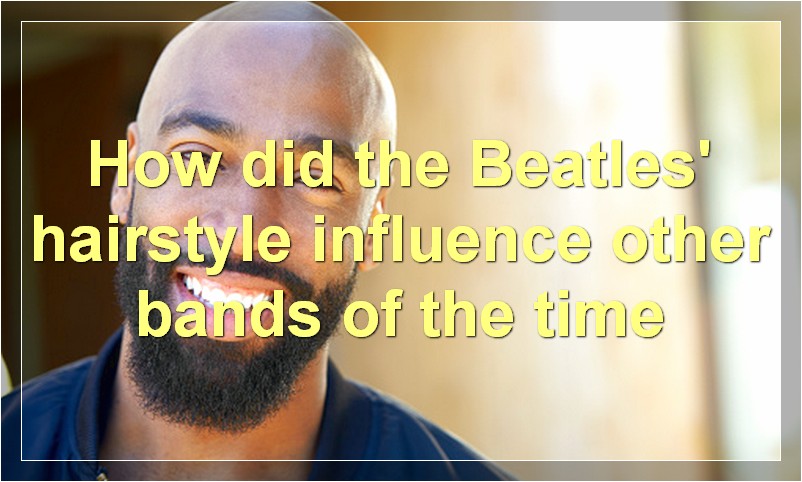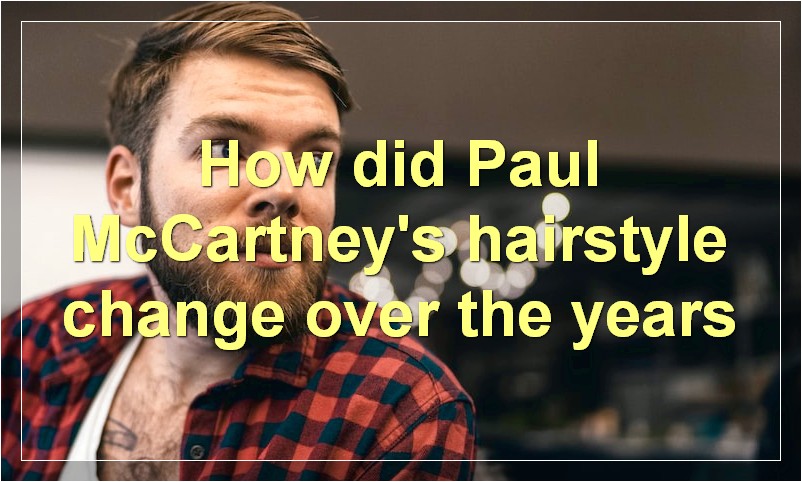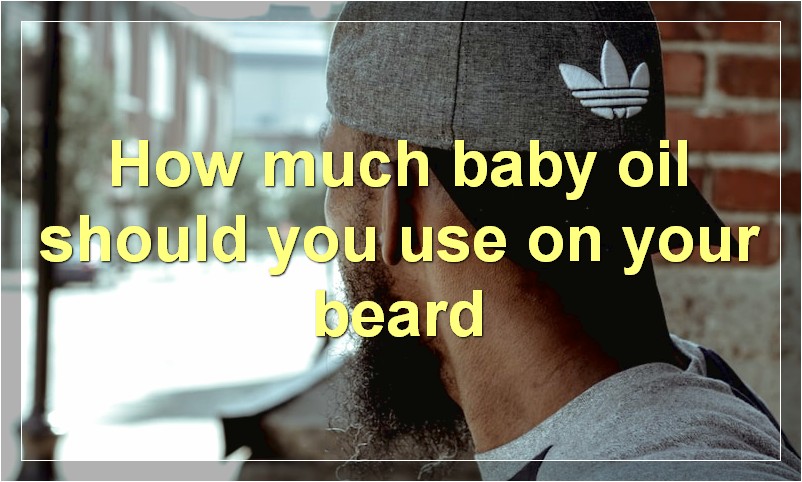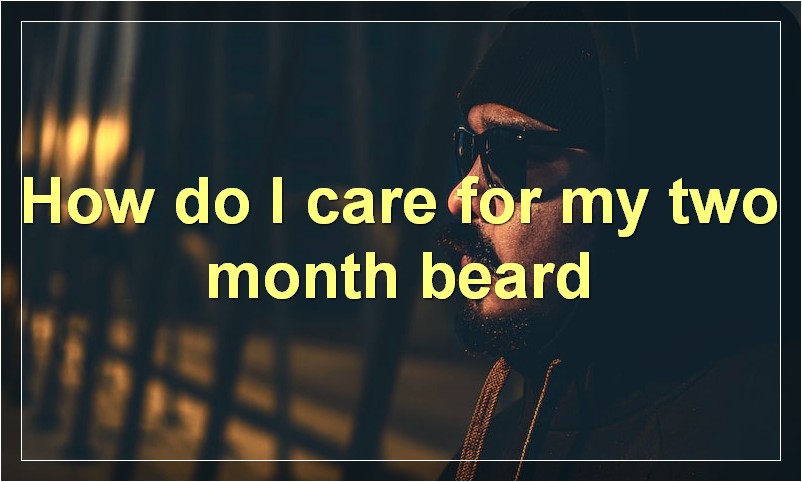The Beatles’ hairstyles were trendsetters in the 1960s, and their hair evolution over the years was influential in fashion.
How did the Beatles’ hairstyle change over the years
The Beatles are one of the most iconic bands in history, and part of their appeal was their unique sense of style. This included their hairstyles, which changed dramatically over the years. In this article, we’ll take a look at how the Beatles’ hairstyles changed over the years, from their early mop-top days to their more experimental styles in the later years.
The Beatles first burst onto the scene in the early 1960s with their now-famous mop-top haircuts. These cuts were simple and uniform, and helped to create the band’s clean-cut image. As the band’s popularity grew, so did the length of their hair. By the mid-1960s, the Beatles were sporting longer, shaggier styles. This change coincided with the band’s growing experimentation with drugs and their more psychedelic sound.
In the late 1960s, the band grew even more experimental, both in their music and in their hairstyles. John Lennon famously grew his hair long and wore round wire-rimmed glasses. Paul McCartney sported a beard for a time. George Harrison had a moustache for a while, and Ringo Starr experimented with a number of different looks. The band’s hairstyles reflected their increasingly rebellious attitude and experimental sound.
By the early 1970s, the Beatles had disbanded and each member pursued solo careers. Their hairstyles changed once again, reflecting their new individual identities. John Lennon grew his hair even longer and sported a beard for most of the 1970s. Paul McCartney also had long hair during this period, though he often wore it in a more conservative style. George Harrison sported a beard throughout much of the 1970s, while Ringo Starr kept his hair relatively short.
The four former Beatles have all continued to change their hairstyles over the years, but they will always be remembered for the styles they wore during their time as a band. The Beatles’ hairstyles were as iconic as their music, and helped to define an entire generation.
How did the Beatles’ hairstyle influence other bands
When the Beatles burst onto the scene in the early 1960s, they not only changed the sound of popular music, but also the way people looked at hair. The mop-top haircuts sported by John Lennon, Paul McCartney, George Harrison and Ringo Starr were a stark contrast to the slick, styled hair that was popular at the time. The Beatles’ hairstyle was an instant hit with young people around the world and influenced other bands to adopt similar styles.
While the Beatles may have been the pioneers of the mop-top hairstyle, they were certainly not the only ones to embrace it. In the years that followed, many other bands copied the look, including the Rolling Stones, the Kinks and Herman’s Hermits. Even today, mop-tops are still worn by musicians such as Justin Bieber and Harry Styles.
The Beatles’ hairstyle was so influential that it even spawned its own term: “Beatlemania.” This was used to describe the hysteria that surrounded the band during their tours and appearances. Fans would scream and swoon over the Fab Four, and their hairstyles only added to their appeal.
While the mop-top may have been short-lived (the Beatles abandoned it in 1966 in favor of longer, more mod styles), its impact on popular culture is still felt today. The Beatles may have looked like a bunch of scruffy kids when they first arrived on the scene, but their hairstyles helped change the face of music forever.
How did the Beatles’ hairstyle influence fashion in the 1960s
When the Beatles first arrived on the music scene in the early 1960s, they were sporting a very clean-cut look. Their hair was styled in what was known as the “mop-top” style – short and neatly parted on the side. This look was in stark contrast to the longer, shaggier styles that were popular at the time.
As the Beatles’ popularity grew, so did the popularity of their hairstyle. Young men all over the world began emulate the “mop-top” look. Suddenly, shorter hair was cool and stylish.
The Beatles’ influence on fashion didn’t stop there. In 1967, they shocked the world by debuting a new look – long hair parted in the middle and styled in loose, flowing locks. This style, known as the “Beatle cut,” quickly became wildly popular, especially among young women.
Once again, the Beatles had started a trend that would change the course of fashion history. The “Beatle cut” would go on to inspire many of the most popular hairstyles of the late 1960s and early 1970s, including the iconic “pixie cut” worn by Audrey Hepburn in “Roman Holiday.”
So how did a group of four young men from Liverpool end up having such a profound impact on fashion? It’s simple – they had great hair!
What were some of the most popular Beatles’ hairstyles
When it comes to iconic hairstyles, the Beatles definitely had a few that have stood the test of time. Here are some of the most popular Beatles’ hairstyles:
The mop top: This was the Beatles’ signature look in their early years and is still one of their most recognizable styles. To achieve this look, simply let your hair grow out until it’s about chin-length and then style it into place with a little bit of product.
The faux hawk: This style was popularized by John Lennon in the later years of the Beatles and has since been copied by many celebrities. To get this look, simply style your hair into a Mohawk shape (without shaving the sides) and then use some product to hold it in place.
The Beatle bob: This is a shorter, more polished version of the mop top and was worn by both John Lennon and Paul McCartney during the latter years of the band. To achieve this look, get a short, layered haircut and then style it into place with a little bit of product.
How didJohn Lennon’s hairstyle change over the years
John Lennon’s hairstyle changed quite a bit over the years, from the mop-top look of the early Beatles days to the longer, shaggier style he sported in the late 1960s. In the early 1970s, Lennon went through a “primal scream” phase where he let his hair grow wild and unkempt. He also experimented with facial hair, at one point growing a mustache and goatee.
Lennon’s hair was always something of a fashion statement, and he often used it as a way to express himself and his beliefs. In the late 1960s, he grew his hair long in support of the anti-war movement. He also wore his hair in an Afro during the 1970s as a way of embracing his African heritage.
No matter what style he was sporting at any given time, John Lennon’s hair was always iconic and instantly recognizable. It was just one of the many things that made him such a unique and unforgettable figure.
How did Paul McCartney’s hairstyle change over the years
Paul McCartney is a man who is well known for his music, but he is also known for his hairstyle. Over the years, Paul’s hairstyle has changed quite a bit. In the early days of his career, Paul sported a mop top hairstyle that was very popular in the 1960s. This hairstyle consisted of short, dark hair that was parted in the middle. As Paul’s career progressed, he began to experiment with different hairstyles. He grew his hair out and styled it in a variety of ways. In recent years, Paul has gone back to his roots and now sports a mop top once again.
Paul McCartney’s hairstyle has been an important part of his image over the years. His hairstyle has helped him to stand out from the rest of the Beatles and has helped to make him a style icon. Paul’s hairstyle has also been a source of controversy at times. In 1967, Paul shocked fans when he appeared on the cover of Sgt. Pepper’s Lonely Hearts Club Band with his hair dyed blonde. This caused quite a stir and many people thought that Paul had gone too far with his new look.
Over the years, Paul McCartney’s hairstyle has changed quite a bit, but he always seems to find a way to stay relevant and stylish. Paul is a true fashion icon and his hairstyles have played a big role in his success.
How did George Harrison’s hairstyle change over the years
When it comes to the hairstyles of George Harrison over the years, there is no one definitive answer. This is because Harrison’s hairstyle changed many times throughout his lifetime, reflecting his ever-evolving personal style.
George Harrison’s earliest known hairstyle was the traditional bowl cut sported by many young boys in the 1950s. Harrison’s hair was short and neatly combed back off his forehead. As he entered his teenage years, Harrison began to experiment with longer, shaggier styles. He grew his hair out into a chin-length bob in the mid-1960s, before letting it grow even longer and experimenting with fringe styles in the late 1960s.
By the early 1970s, Harrison had settled on a signature look that would become synonymous with his image: long, flowing hair parted down the middle. This style was often worn with a beard, and became Harrison’s go-to look for much of the 1970s. In the later years of the decade, Harrison began to experiment with shorter, more controlled styles, culminating in the famous “Beatle bob” he wore in the early 1980s.
In the 1990s and 2000s, Harrison’s hair began to thin out considerably. He compensated for this by keeping his hair relatively short and tidy. In his later years, Harrison returned to his roots, sporting a chin-length bob similar to the style he wore in the mid-1960s.
Throughout his life, George Harrison’s hairstyles reflected his personality and style at any given time. Whether he was rocking a bowl cut or a Beatle bob, Harrison always looked like the cool, stylish Beatle we all know and love.
How did Ringo Starr’s hairstyle change over the years
Ringo Starr’s hairstyle has undergone a number of changes over the years. He first rose to prominence as the drummer for The Beatles, sporting a mop top hairstyle that became iconic in the 1960s. As he matured, Ringo began to experiment with different looks, including a shaggy style in the 1970s and a balding look in the 1980s. In recent years, he has sported a shorter, more polished style that reflects his status as a rock legend.
Ringo Starr’s hairstyle is as iconic as his music. The mop top look he sported in the 1960s made him a fashion icon for an entire generation. As the years went by, Ringo began to experiment with different styles, reflecting his own personal journey and evolution.
In the 1970s, Ringo rocked a shaggy style that was popular at the time. He also experimented with facial hair, growing a mustache and goatee. This look reflected his more laid-back, carefree attitude in the post-Beatles years.
As he entered his 40s, Ringo began to lose his hair, leading him to shave his head bald in the 1980s. This look was in stark contrast to his previous styles, but it suited him well. In recent years, Ringo has embraced his age and status as a rock legend by sporting a shorter, more polished hairstyle.
No matter what style he’s rocking, Ringo Starr will always be remembered as one of the most iconic musicians of all time.
What were some of the most popular men’s hairstyles in the 1960s
The 1960s saw a lot of changes in men’s hairstyles. The clean-cut look of the 1950s gave way to more experimentation and individuality. Here are some of the most popular hairstyles for men in the 1960s.
The Ivy League Cut
The Ivy League cut was a preppy look that was popularized by students at Ivy League colleges. It consisted of short sides and a longer top that was parted on the side. This style was often worn with a crew cut.
The Beatle Cut
The Beatles were one of the biggest influences on fashion in the 1960s, and their signature mop-top haircuts were copied by men all over the world. The Beatle cut was a long, shaggy style that was usually worn with bangs.
The Afro
The Afro was popularized by African American celebrities like James Brown and Jimi Hendrix. This style consisted of large, round mound of hair on top of the head. The Afro could be styled in many different ways, but it was always big and bold.
The Mullet
The mullet is a style that has been around for centuries, but it reached its peak popularity in the 1980s. This style consists of short hair on the sides and long hair in the back. The mullet can be worn with or without bangs.
The Crew Cut
The crew cut is a timeless style that has been popular since the 1920s. This style consists of short, closely cropped hair on the sides and back with a little bit more length on top. The crew cut is a versatile style that can be worn casual or formal.
What were some of the most popular women’s hairstyles in the 1960s
The 1960s were a time of great change for women, and their hairstyles reflect that. From the iconic beehive to the mod bob, these are some of the most popular women’s hairstyles of the 1960s.
The beehive was one of the most popular hairstyles of the 1960s. This style was achieved by backcombing the hair to create a tall, round shape. It was often decorated with flowers or other accessories.
The mod bob was another popular hairstyle of the 1960s. This style was characterized by short, straight hair that was often worn with a fringe. It was a simple and stylish look that was perfect for the fashion-forward woman.
The Afro was also a popular hairstyle in the 1960s. This style was achieved by allowing the hair to grow out naturally, without any chemical treatments. It was a symbol of black pride and empowerment.
These are just some of the most popular women’s hairstyles of the 1960s. These styles were reflective of the times, and they continue to inspire women today.
Table of Contents






